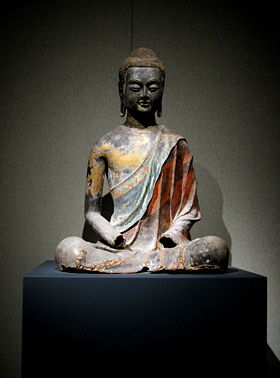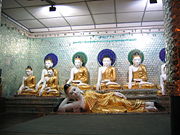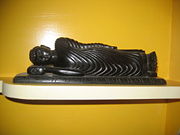Buddhahood
2008/9 Schools Wikipedia Selection. Related subjects: Religious figures and leaders
| This article contains Indic text. Without rendering support, you may see question marks, boxes or other symbols instead of Indic characters; or irregular vowel positioning and a lack of conjuncts. |

In Buddhism, buddhahood (Sanskrit: buddhatva. Pali: buddhatta. Or (both) buddhabhāva) is the state of perfect enlightenment (Sanskrit: samyaksambodhi. Pali: sammāsambodhi) attained by a buddha (Pali/Sanskrit for "awakened one").
In Buddhism, the term 'buddha' usually refers to one who has become enlightened (i.e., awakened to the truth, or Dharma). The level to which this manifestation requires abstraction from ordinary life ( ascetic practices) varies from none at all to an absolute requirement, dependent on doctrine. In Theravada Buddhist traditions, it is held that the person attains this state on their own, without a teacher to point out the Dharma, in a time when the teachings on the Four Noble Truths or the Eightfold Path do not exist in the world, and teaches it to others. In contrast, certain Mahayana Buddhist traditions (particularly those that consider the teachings of the Lotus Sutra to be paramount, which contains this concept) Buddhahood is considered to be a universal and innate property of absolute wisdom that is revealed in a person's current lifetime through Buddhist practice, without any specific relinquishment of pleasures or "earthly desires". Thus, there is an extremely broad spectrum of opinion on the universality and method of attainment of Buddhahood which is correlated to which of Shakyamuni Buddha's teachings that a school of Buddhism follows.
More broadly, it is occasionally used to refer to all who attain nirvana.. In this broader sense it is equivalent to Arahant. According to Theravada Buddhism, all Arahants (or Buddhas in the broader sense) are the same in the most fundamental aspects of Liberation ( Nirvana), but differ in their practice of perfections paramis. Mahayana Buddhism, however, considers there is a fundamental difference between Buddhas and ordinary arhants, on the way to becoming a Buddha, a buddhist proceeds bodhisattva stages. Buddhists do not consider Siddhartha Gautama to have been the only Buddha. The Pali Canon refers to many previous ones (see List of the 28 Buddhas), while the Mahayana tradition additionally has many Buddhas of celestial, rather than historical, origin (see Amitabha or Vairocana as examples, lists of many thousands buddha names see Taisho Tripitaka no 439-448). A common Theravada and Mahayana Buddhist belief is that the next Buddha will be one named Maitreya (Pali: Metteyya).
Kinds of Buddha
In the Pali commentaries, three kinds of buddha are mentioned:
- Sammasambuddhas attain buddhahood, then decide to teach others the truth they have discovered. They lead others to awakening by teaching the Dhamma in a time where it has been forgotten. Siddhartha Gautama is considered a sammasambuddha. (See also the List of the 28 Buddhas (all of whom are sammasambuddhas).)
- Paccekabuddhas, sometimes called 'silent Buddhas' are similar to sammasambuddhas in that they attain nirvana and acquire many of the same powers as a sammasambuddha, but are unable to teach what they have discovered. They are considered second to the sammasambuddhas in spiritual development. They do ordain others; their admonition is only in reference to good and proper conduct (abhisamācārikasikkhā). In some texts, the paccekabuddhas are described as those who understand the Dhamma through their own efforts, but obtain neither omniscience nor mastery over the 'fruits' (phalesu vasībhāvam).
- Savakabuddhas attain nirvana after hearing the teaching of a sammasambuddha (directly or indirectly). The disciple of a sammasambuddha is called a savaka ("hearer" or "follower") or, once enlightened, an arahant. These terms have slightly varied meanings but can all be used to describe the enlightened disciple. Anubuddha is a rarely used term, but is used by the Buddha in the Khuddakapatha to refer to those who become Buddhas after being given instruction. Enlightened disciples attain nirvana and parinirvana as the two types of Buddha do. Arahant is the term most generally used for them, though it is also applicable to Buddhas.
In the Pali Canon itself, the first two are mentioned by the above names, while numerous examples of the third type occur, without that name. There is no mention of types of buddhas, though the word buddha does sometimes appear to be used in a broad sense covering all the above.
Characteristics of a Buddha
Nine characteristics
Some Buddhists meditate on (or contemplate) the Buddha as having nine characteristics:
- a worthy one (Skt: arhat)
- perfectly self-enlightened (Skt: samyak-saṃbuddha)
- perfected in knowledge and conduct (Skt: vidyā-caraṇa-saṃpanna )
- well gone (Skt: sugata)
- unsurpassed knower of the world (Skt: anuttara-loka-vid)
- unsurpassed leader of persons to be tamed (Skt: anuttara-puruṣa-damya-sārathi)
- teacher of the gods and humans (Skt: śāstṛ deva-manuṣyāṇaṃ)
- the Enlightened One (Skt: buddha)
- the Blessed One or fortunate one (Skt: bhagavat)
These characteristics are frequently mentioned in the Pali Canon, and are chanted daily in many Buddhist monasteries.
Other names
In several other suttas of the Pali canon, the Tathagatha is also known by the following epithets, among many others:
- 1. Dhammakayo (body of the law)
- 2. Brahmakayo (body of Brahman)
- 3. Dhammabhuto (become the Dhamma)
- 4. Brahmabhuto (become Brahma).
- 5. Cakkhubhuto (become the eye)
- 6. Jnanabhuto (become knowledge)
- 7. Amatassa data (bestower of immortality)
- 9. Dhamma Sami (skt. Dharma swami or Lord of the Law).
- 10. Uttamapuriso (the supreme man)
- 11. Paramapuriso (the superlative man)
- 12. Paramapattippatto (attainer of the supreme attainment)
- 2. Brahmakayo (body of Brahman)
Mahayana names
In the Lankavatara Sutra he is known by the following names:
- The Self-existing One (svayambhuva), the Leader (nayaka), the Remover-of-obstacles (vinayaka), the Guiding One (parinayaka),
- Buddha, Rishi, Bull-king, Brahma, Vishnu, Isvara [God], the Originator (pradhana), Kapila, the Destroyer (bhutanta) [or: the
- Extreme of Reality], the Imperishable (arishta), Nemina, Soma (moon), Fire, Rama, Vyasa, Suka, Indra, the Strong One (Balin),
- or Varuna; there are others who know me as Immortality (anirodhanutpada) [literally: non-Cessation, non-Arising], Emptiness,
- Suchness, Truth (satyata), Reality (bhutata), Limit of Reality (bhutakoti), Dharmadhatu [Realm of Dharma], Nirvana, Eternity
- (nitya), Sameness (samata), Non-Duality (advaya), the Imperishable (anirodha) [literally: Non-Cessation; Non-Extinction, Non-
- Ending], Formless (animitta) [literally: Without Characteristic Marks/ Qualities], Causality [pratyaya), Teaching the Cause
- of Buddhahood (buddha-hetupadesa), the All-Knowing (sarvajna), the Conquering One [or Conqueror] (jina), or the Will-body
- (manomayakaya).
- Buddha, Rishi, Bull-king, Brahma, Vishnu, Isvara [God], the Originator (pradhana), Kapila, the Destroyer (bhutanta) [or: the
Ashvaghosha in his "Acts of the Buddha" states,
"A narrator could spend a kalpa [eon] but the virtues of the Buddha would not come to an end…": "He makes wise all the ignorant ["illuminates those in the dark"] that's why he is called "Buddha." (Also,) this knowledge of the laws of reality has been ascertained by me and from myself distinct from all teaching by any other person, and therefore is he called "Self-existent." And, having all laws [dharmas] under his control, he is called "Lord of Law" (Dharmaraja.) "He knows what is right (naya) and wrong (anaya) with regard to laws, therefore he is called "Nayaka," teaching innumerable beings as they become fit to be taught. (Because) he has reached the furthest limit of instruction, therefore is he called "Vinayaka," from his pointing out the best route to beings who have lost their way. "He has reached the furthest extent of good teaching; he is the guide to all Dharma, attracting all beings by his knowledge of all the means of conciliation (his ability to synthesize -- to formulate.) "He has passed through the forest of mundane existence, so he is called Caravan Leader; and as absolute ruler over all law he is the Jina, Victorious One. "From his setting in motion this Wheel of Law he is the lord of all (other) sovereigns of Law (law-givers); the Master-giver of Dharma, The Teacher, Master of the Dharma -- the Lord of the World. "He who has offered the sacrifice, accomplished his end, fulfilled his hope, achieved his success, the consoler, the loving-regarder [cf. Avalokiteshvara,] the Hero, the champion, the victorious one in conflict. (As) he has emerged from all conflict, released himself and the releaser of all, he is become Light of the World, Illuminator of the Knowledge of True Wisdom: "The dispeller of the darkness of ignorance, Illuminator of the Great Torch; Great Physician, Great Seer -- the Healer of all evils who is the extractor of the barb of evil from all those wounded by evil. He is possessed of all distinctive marks and adorned with all signs. With his body and limbs in every way perfect, of pure conduct and perfectly clear mind, possessed of the ten powers, having great fortitude, learned in all learning, "Endowed with all independent states:" Attainer of the Great Vehicle (Mahayana;) "Lord of all Dharma:" the Ruler, Monarch of All Worlds, the Sovereign; "Lord of all wisdom:" the wise, the destroyer of the pride of all disputers, the omniscient, the Arhat, Possessor of Perfect Knowledge, the Great Buddha, Lord of Saints; "The Victorious:" triumphant over-thrower of the insolence and pride of the evil Mara, the Perfect Buddha, Sugata, the wise one who fulfills the wishes of all beings, "Ever cognizant of past acts, never speaking falsely, a mine of perfect excellence and of all good qualities; destroyer of all evil ways and guide to all right ways, "The ruler of the world, bearer of the world, master of the world, sovereign of the world, teacher of the world, preceptor of the world (since) he brings to the world the Law, virtue and its reward (true end.) The Fount of Nectar that quenches the scorching flame of all pain, and the powerful luminary [the sun] which dries up the great ocean of all suffering. Bringer of all virtue and all real wealth; possessor of perfect excellence and all good qualities; the guide on the road of wisdom who shows the way to Nirvana. "Tathagata without stain, without attachment, without uncertainty. That is the compendious [signature to this] declaration of the Turning of the Wheel of Law.
Spiritual realizations

All Buddhist traditions hold that a Buddha has completely purified his mind of desire, aversion and ignorance, and that he is no longer bound by Samsara. A Buddha is fully awakened and has realized the ultimate truth, the non-dualistic nature of life, and thus ended (for himself) the suffering which unawakened people experience in life.
Nature of the Buddha
The various Buddhist schools hold some varying interpretations on the nature of Buddha (see below).
Buddha as a supreme human
Different schools view Buddha differently, with Theravada Buddhism emerges the view that the Buddha was human, endowed with the greatest psychic powers ( Kevatta Sutta). The body and mind (the five khandhas) of a Buddha are impermanent and changing, just like the body and mind of ordinary people. However, a Buddha recognizes the unchanging nature of the Dharma, which is an eternal principle and an unconditioned and timeless phenomenon. This view is common in the Theravada school, and the other early Buddhist schools.
Although the Theravada school does not emphasize the more supernatural and divine aspects of the Buddha that are available in the Pali Canon, elements of Buddha as the supreme person are found throughout this canon.
In MN 18 Madhupindika Sutta, Buddha is described in powerful terms as the Lord of the Dhamma (Pali: Dhammasami, skt.: Dharma Swami) and the bestower of immortality (Pali: Amatassadata).
Similarly, in the Anuradha Sutta (SN 44.2) Buddha is described as " the Tathagata — the supreme man, the superlative man, attainer of the superlative attainment". Buddha is asked about what happens to the Tathagatha after death of the physical body.
Buddha replies, "And so, Anuradha — when you can't pin down the Tathagata as a truth or reality even in the present life — is it proper for you to declare, 'Friends, the Tathagata — the supreme man, the superlative man, attainer of the superlative attainment — being described, is described otherwise than with these four positions: The Tathagata exists after death, does not exist after death, both does & does not exist after death, neither exists nor does not exist after death'?"
In the Vakkali Sutta Buddha identifies himself with the Dhamma:
- O Vakkali, whoever sees the Dhamma, sees me [the Buddha]
Another reference from the Agganna Sutta of the Digha Nikaya, says to his disciple Vasettha:
- O Vasettha! The Word of Dhammakaya is indeed the name of the Tathagata
In the Pali Canons Gautama Buddha is known as being a "teacher of the gods and humans", superior to both the gods and humans in the sense of having nirvana or the greatest bliss (whereas the devas or gods of the Vedic era were still subject to anger, fear, sorrow, etc.).
Eternal Buddha in Mahayana Buddhism

In some sutras found in Mahayana Buddhism, the Buddha teaches that the Buddha is no longer essentially a human being but has become a being of a different order altogether and that, in his ultimate transcendental "body/mind" mode as Dharmakaya, he has eternal and infinite life, is present in all things (i.e., is "the boundless dharmadhatu", according to the Nirvana Sutra), and is possessed of great and immeasurable qualities. In the Mahaparinirvana Sutra the Buddha declares: "Nirvana is stated to be eternally abiding. The Tathagata [Buddha] is also thus, eternally abiding, without change." This is a particularly important metaphysical and soteriological doctrine in the Lotus Sutra and the Tathagatagarbha sutras. According to the Tathagatagarbha sutras, failure to recognize the Buddha's eternity and - even worse - outright denial of that eternity, is deemed a major obstacle to the attainment of complete awakening ( bodhi).
For the Tibetan Buddhist master, Dolpopa, and his Jonangpa School, the Buddha is to be understood as the wondrous and holy wish-fulfilling Essence of all things, beyond comprehension:
"Buddha - an essence of immeasurable, incomprehensible, unfathomable, excellent exalted body, wisdom, qualities, and activities extremely wondrous and fantastic - is vast like space and the holy source, giving rise to all that is wished by sentient beings like a wish-granting jewel, a wish-granting tree …" (Dolpopa, Mountain Doctrine, tr. by Jeffrey Hopkins, Snow Lion Publications, 2006, p. 424).
Depictions of the Buddha in art
Buddhas are frequently represented in the form of statues and paintings. Commonly seen designs include:
- the Seated Buddha
- the Reclining Buddha
- the Standing Buddha
- Hotei or Budai, the obese Laughing Buddha, usually seen in China (This figure is believed to be a representation of a medieval Chinese monk who is associated with Maitreya, the future Buddha, and is therefore technically not a Buddha image.)
- the Emaciated Buddha, which shows Siddhartha Gautama during his extreme ascetic practice of starvation.
The Buddha statue shown calling for rain is a pose common in Laos.
Markings
Most depictions of Buddha contain a certain number of markings, which are considered the signs of his enlightenment. These signs vary regionally, but two are common:
- a protuberance on the top of the head (denoting superb mental acuity)
- long earlobes (denoting superb perception)
In the Pali Canon there is frequent mention of a list of 32 physical marks of Buddha.
Hand-gestures
The poses and hand-gestures of these statues, known respectively as asanas and mudras, are significant to their overall meaning. The popularity of any particular mudra or asana tends to be region-specific, such as the Vajra (or Chi Ken-in) mudra, which is popular in Japan and Korea but rarely seen in India. Others are more common; for example, the Varada (Wish Granting) mudra is common among standing statues of the Buddha, particularly when coupled with the Abhaya (Fearlessness and Protection) mudra.

